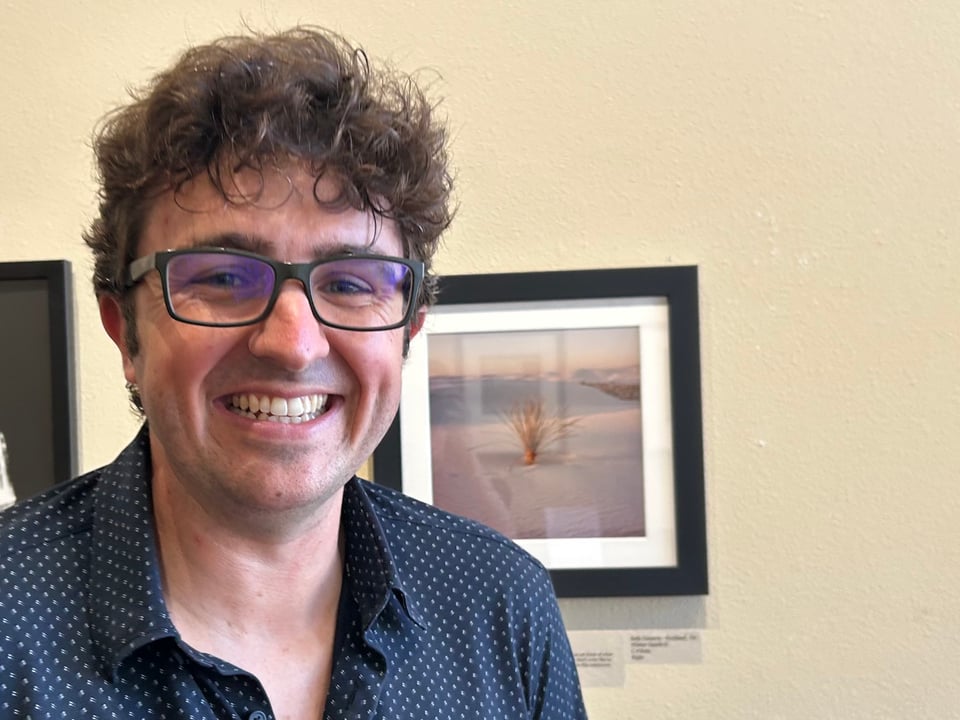Negligence of the gods
In this issue of Idiosyncratic Musings, the self-promotional housekeeping is heavy on photography; we learn about a beautiful dog; the letters of one of my favorite novelists lead me to adore her even more; and the world is reduced to nothing.
I. Promotion of self & others

I’m proud to say a print of this photograph from White Sands National Park is on the wall of LightBox Photographic Gallery in Astoria, OR, until October 8. If you find yourself on the Oregon coast as summer winds down, please check it out.
It’s part of an annual show of analog photography that includes all sorts of historical & alternative processes. (My process was nothing so exciting.) Impossible to pick favorites but there are two other pictures from Portland photographers, both of which I loved: one & two. In the upstairs gallery till September 10 are two rooms of Jim Fitzgerald’s extraordinary carbon-transfer prints from 8”x10” & 14”x17” negatives. Carbon transfer, as Jim’s website tells us, was “perfected in 1864 by Joseph Swan.”
The day Peyton & I delivered my print to the gallery, I had in my backpack a book by Robert Adams, a favorite photographer of mine since long before we moved to Oregon. If Why People Photograph never fully satisfies its title—& of course the explanation I want is not of people but of myself—it has its share of gems. Adams describes the “stereotypical image of a photographer” as “that of a mildly contemptible, self-indulgent dilettante.” Perfect.
It’s validating when he writes that the darkroom “never interested me except as a means to an end; the place I wanted to be was outside in the light.” I feel the same way with infinitely less justification. And here’s a creed I wish everyone lived by: “If you believe in the merit of your work you reject the accusation of failure that is implied by a request to explain it.”
To his credit, although Adams is justly famous for his writing about photography, none of it can live up to his actual photographs.
At some point I must have known that Robert Adams had moved to Astoria, but the thought never crossed my mind. Right or wrong, I associate him with Colorado. So I was equal parts delighted & dismayed that day to learn that he had shown new work at LightBox last fall—dismayed because we had missed it. The proprietor of the gallery, Michael Granger, who did a lot of the darkroom work on the project, still had proofs to show us of the book that resulted: Thalia, which is worth finding. May we all, like Robert Adams, be creating something beautiful at age 87.
II. Endless affection

A print of this photo was on display at the Praxis Gallery & Photo Center in Minneapolis this June & July. Greta, the subject, belongs to our friends Bridget & Lech here in Portland. Much appreciation to friends of the newsletter who went to see this show even though I couldn’t.
One project I daydream about is to snap portraits of the many dogs of our friends & family, then ask their owners to provide capsule bios. I’m a long way from implementing this on a grander scale, but with Greta’s photo finding its way into the world, it seemed like the time to start.
Here is what Bridget & Lech had to say:
Greta is a sweet, sensitive soul with a shepherd's fierce instinct to protect her people and her territory above all else. Adopted at age one, we know little about her past other than the existence of fourteen birdshot pellets that turned up in an X-ray of her front leg last year. These days her life is filled with the things she loves most: regular park outings, bike rides, backyard critter surveillance, beach trips, long naps on the couch, and endless affection. She has adjusted to the addition of a tiny human to the family with grace, some begrudging hesitancy, and more than one wistful glance out the window.
Thanks friends & thanks Greta!
III. Hazzard – Keene
It makes me queasy to think that Shirley Hazzard was only a name to me until 2023, when friend of the newsletter Elizabeth N. recommended I read The Transit of Venus. What a gift! I didn’t so much read it as stand in front of each sentence as one would a stained-glass window.
Now I love Shirley Hazzard. I love her so much that I went to Powell’s yesterday looking for her book on Kurt Waldheim. (It wasn’t for love of Kurt Waldheim.) Instead I came home with a book of her correspondence with Donald Keene, the professor of Japanese literature.
To call him a professor of Japanese literature undersells Keene’s 20th century cachet as cultural interpreter & model of Japanese-American understanding—a career very much of its postwar moment. It’s hard to imagine these cultures needing bridged today, but Keene published his Japanese Literature: An Introduction for Western Readers in 1955. Even a century after the opening of Japan, you can see how he became important to his adopted country. He was, as one of many awards from the Japanese government deemed him, a “person of cultural merit.”
I’ve never been a big reader of collected letters (Hazzard’s husband Francis Steegmuller translated Flaubert’s) but I’m learning the same lesson as with biographies, which bored me to tears until I stopped trying American presidents in favor of writers & artists I care about. In this case, I care a lot about Shirley Hazzard & I care a lot about Japanese literature & the letters were like heroin, if heroin had prose style.
Going in I had less attachment to Keene, but I liked him from the start. He does plenty of his own self-promotional housekeeping & complains about his lecture schedule in every letter for thirty years, but he’s kind & engaging & nearly as cosmopolitan as Hazzard is—& toward the end, lonely. It’s not easy keeping up with his annual peregrinations from New York to Tokyo & points in between. Hazzard, whose biography like her fiction was global & who split her time between New York & Capri, seems fixed in place by comparison. How any of these letters reached either of them at the proper address is a mystery & one of their frequent topics.
Keene’s hyperactivity went beyond far-flung lecturing. Every year he reports the completion of a book or two, most of them released in both languages. Meanwhile, on his correspondent’s side, 23 years & 150 pages of letters elapse between The Transit of Venus & The Great Fire.
The pleasure of the book, though, is “Shirley”—to eavesdrop as she discusses her favorite Kawabata (The Master of Go), her favorite translation of War & Peace (Rosemary Edmonds), her blasé attitude toward the Times of London crossword. This last, her ease with a puzzle that bedevils mere mortals & is even worse for Americans, comes as no surprise. She quotes all poetry from memory, usually in the original, & has opinions on all art since Pompeii went under. As Keene, no slouch himself, is constantly reminding her, she has read everything.
It’s her writing I love & simply a bonus that I often agree with what she says.
1982: “Thank God we still know many exemplary scholars and devoted teachers; but they are often embattled within the scholarly context.”
1983: “Since your departure, an appalling edifice has opened at 57th and Fifth, the Trump Tower, a temple to crass materialism.”
1986: “‘What I really want to buy is time,’ you say. Yes, not only time to write, but time for the state of mind and thought; time for prolonged and habitual silences.”
2001, on Bill Maxwell reading War & Peace in the final months of his life: “Sometimes he and I would go over a scene he had just read—not, oh God, ‘discussing’ it, still less ‘interpreting’ it, but giving the homage of our pleasure in it.”
2004: “[W.G.] Sebald's death, a mindless accident, was an example of the indifference and negligence of the gods: the most evil political figures live on without a scratch … while one's beloved friends and admired heroes disappear.”
IV. The Great Nothing
You may remember the final section in my last newsletter about the world neither looking nor sounding like anything. I was reluctant to include that section because it is so transparently a topic that philosophers & scientists have considered in serious ways for centuries. The term dilettantism would be too kind. But I decided, first, that I’d hear from smart people who know what they're talking about, which has been true & not too condemnatory, & second, that the rest of us so rarely register the full strangeness of existence that it is worth making the most common-sense case however many times it’s been made before.
To the first point, this note from friend of the newsletter Jim T.:
This is my subject. It was a Perception class that set me on my career path, the shockingly clever methods used by the brain to interpret waves of sound and light to create useful heuristics like shape and color and distance and volume and to then infer useful conclusions to help us get what we want to survive, and to avoid the things that might interfere. You put it very well. Things don't really sound or look like anything. I would like to further suggest that there is nothing anywhere, that things don't actually exist to be seen or heard. It is all made of atoms that are almost entirely empty … It consists of tiny particles flying around a tiny center but there is virtually no substance to them. They function as they do because of the forces of the particles. It struck me very hard in class one day when the professor in Physical Chemistry was making this point, that when you hit an 8 ball with a cue ball, there are no hard surfaces being struck at all, it is space striking space - when you hit a table with your fist, the fist and table both are just so much space. The overall effects are from force fields, like when you suspend something with magnets. So, nothing is there where you think you see it, it is all just space. It has no color, no sound, it isn't even there.
The bad news is I still haven’t found that napkin explaining why there is something instead of nothing. The good news is there isn’t much.
See you next time,
seth
